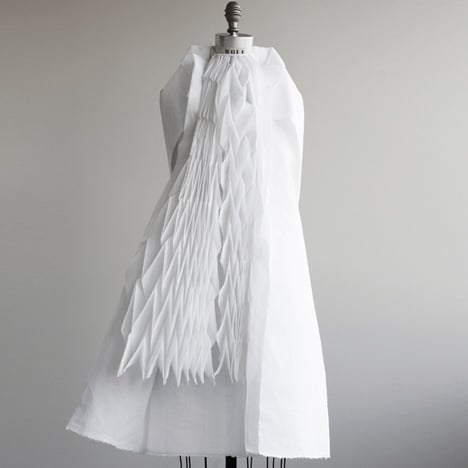These dresses by Montreal fashion designer Ying Gao move as if they're breathing.
Called Walking City, the garments incorporate hidden pneumatic pumps that fill origami-style folds in the fabric with air.
The pumps in one dress are activated by movement sensors that detect approaching spectators, while a second version reacts to sounds picked up through a dangling microphone.
The project is on show at the Musée national des beaux-arts du Québec in Canada, entitled Ying Gao: Art, Fashion and Technology.
The exhibition continues until 28 August.
Photographs are by Dominique Lafond.
Here are some more details from Ying Gao:
Ying Gao: Art, Fashion and Technology
June 9 to August 28, 2011
Musée national des beaux-arts du Québec, Canada
In summer 2011, art and fashion meet at the Musée national des beaux-arts du Québec through works by the designer Ying Gao. The exhibition Ying Gao: Art, Fashion and Technology presents a dozen pieces that include three series of interactive garments which move and change in response to noise, sound, motion or light.
These garments represent state-of-the-art research on textiles with integrated technologies but still have an amazingly poetic dimension. They draw the viewer's eye, inflating, unfolding, transforming while protecting the virtual body they cover. A couture experience like no other. For Gao, apparel art serves as a means to investigate the various ways people relate to their environment as well as contemporary complex social and technological issues.
Walking City - three interactive dresses. Cotton, nylon and electronic devices.
Air. A fascinating element at the intersection of colour, light and vibration, it’s also one of the materials used in the project Walking City. These interactive pieces play with the public’s perception: the fluid movement of breathing is simulated using sensors and a pneumatic mechanism that’s sown directly onto nylon and cotton.
These unconventional garments then take on a playful dimension through their inflatable capacity. The pleated fabric in the Walking City pieces take numerous shapes, much like Japanese origami. These pieces are harder to understand than traditional garments, almost fooling the public into seeing them unlike they really are.
If the pneumatic technology featured in Walking City would fit right in if placed in the context of performing arts, it could also be applicable in the ready-to-wear industry.
Light, immaterial, changing and poetic, this concept of inflatable pieces gives life to the garments, with their mechanical movements giving the impression that they are controlled by a body.
The clothes in this project have been created as an homage to British architecture collective Archigram which, in the 1960s, imagined mobile and inflatable habitable structures.
The Walking City dress 1 is hypersensitive to its immediate environment. It reacts to the viewer’s presence by means of a motion detector connected to a pneumatic system. When the piece is filled with air, the fabric origami contract and expand, like a fragile form of protection.
The Walking City dress 2: when the visitor breathes into a microphone hanging nearby, the dress inflates, as if being worn by a body, causing the wide pleat on the front to “breathe”. With this work, I have given aesthetic form to the immaterial—air—while at the same time experimenting with incorporating pneumatic technologies into dressmaking.

